Wind Power Ramp Events Prediction with Hybrid Machine Learning Regression Techniques and Reanalysis Data
Abstract
1. Introduction
1.1. Motivation
1.2. Purpose and Contributions
- The use of regression techniques in this kind of problem since, up until now, the majority of WPRE prediction frameworks have been based on classification approaches, as will be shown in the literature review in Section 2.
- The use of direct reanalysis data as predictive variables of the ML regression techniques. As will be shown, this is because the direct application of regression algorithms makes unnecessary the use of some pre-processing algorithms, which are necessary in other approaches [43,44]. Note that the classification problems associated with WPREs are usually highly unbalanced, which makes it difficult to put into practice high-performance classification techniques without having to use specific over-sampling or similar techniques [43,44].
- The performance of the proposed system has been tested using real data from three different wind farms in Spain.
1.3. Practical Perspectives
1.4. Paper Organization
2. Related Work
2.1. Physical-Based Models
2.2. Statistical Approaches
2.3. Review Conclusions
3. Problem Definition
- Magnitude (): defined as the variation in power produced in the wind farm or wind turbine during the ramp event (subscript “r”).
- Duration (): time period during which the ramp event is produced.
4. Data and Predictive Variables
5. Computational Methods: Machine Learning Regression Techniques
5.1. Support Vector Regression
5.2. Multi-Layer Perceptrons
Extreme Learning Machines
- Randomly assign input weights and bias , .
- Calculate the hidden layer output matrix , defined as:
- Calculate the output weight vector as:where stands for the Moore–Penrose inverse of matrix [83], and is the training output vector, .
5.3. Gaussian Processes for Regression
6. Experimental Work
6.1. Results
6.1.1. Results Using as the Ramp Function Definition
- With respect to the “conventional” metrics that measure errors, there are two reason that have compelled us to include the RMSE and MAE metrics. The first one is that they are the most commonly used in the literature. Examples of relevant papers in which these metrics are used for WPRE forecasting are [28,49,69,90]. Please see [28] for a useful discussion on this issue. The second cause is, as will be shown, that the utility of these error measures can be complemented by using the sensitivity metric, the other class of metrics that we have chosen.
- The second couple of points that are important to be emphasized here are just those related to the aforementioned sensibility in Equation (22), one with respect to its meaning and the other regarding its application. On the one hand, the physical meaning of sensitivity is just the percentage of correct ramp predictions with respect to actual measured data. Despite its apparent simplicity, this is, however, an excellent measure of the extent to which the regressor algorithm under test is efficient in detecting wind ramps. On the other hand, regarding its application step in the proposed methodology, the key point is that sensitivity is only used after having predicted the ramp function with a regression technique and a threshold has been defined. After applying the threshold, the number of real WPREs is thus obtained and compared to the predicted number. This way, the fact that the problem is highly unbalanced is not an issue any longer; or, in other words, we first apply the regression techniques to the ramp function, and then, we establish a threshold to classify events. In this case, the percentage of correct WPRE identifications is obtained. Note that the paper’s objective is to deal with a regression problem, so we do think that it is enough to show the good percentage of correct classification after the threshold setting in the predicted ramp function.
- The performance of the ML regressors is, in general, good in terms of RMSE, MAE and sensitivity s, although, as shown, there are some ML regressors that work better than others.
- Regarding the performance of one regressor with respect to that of another, the results of Table 4 clearly indicate that the GPR model reaches the best results of all the regressors tested, with an excellent reconstruction of the ramp function from the ERA-Interim variables. Note in Table 4 that we have marked in bold the values of the metrics obtained by the GPR regressor. Its RMSE and MAE values are much lower (better) than those of the other ML regressors explored. In terms of sensitivity, its performance is even better. Specifically, its sensitivity s (or percentage of correct predictions (with respect to the real, measured data) stated by Equation (22)) is much higher (better) than those of the other regressors: s (+ramp)s (+ramp) (for ascending ramps) and s (−ramp)s (−ramp) (for descending ramps). This confirms the validity of the results measured with the error metrics and proves the feasibility of the proposed methodology for predicting wind ramps, both ascending and descending ramps.
- The worst result corresponds to the MLP, with a poorer detection of positive WPREs, when compared to the other ML regressors.
- The SVR and ELM work well in between both GPR and MLP, with acceptable values of detection in positive WPREs.
- Aiming at clearly showing the algorithms’ performance, only the 300 first samples of the test set have been represented in these figures.
- Furthermore, a threshold value (and the corresponding ) has been marked in these figures, so it can be used to decide whether or not the event is a ramp power event (see Equation (3)). When a ramp occurs, it is possible to decide whether the ramp event is ascending or descending.
6.1.2. Results Using as the Ramp Function Definition
6.2. Discussion
- The use of reanalysis data as predictive variables for WPRE forecast has the following beneficial properties:
- Reanalysis makes the training of the ML regressors easier if there are enough measures of the objective variables. This is just the case in our approach because reanalysis data provide robust meteorological variable estimation back to 1979 in the case of the ERA-Interim reanalysis, with high spatial and enough temporal resolution to tackle this problem.
- The variables from reanalysis projects are similar to those by any weather numerical forecast system, even meso-scale ones, so it is straightforward to tackle the WPRE prediction by using alternative models, such as the well-known Weather Research and Forecasting (WRF) meso-scale model [91], to predict future values of the predictive variables and, then, the corresponding WPRE prediction for a given wind farm.
- The use of reanalysis data allows the repeatability of the described experiments by other researchers since such data are freely available on the Internet.
- The performance studies of the state-of-the-art ML regressors, the other pillar our approach is based on, have shown that the GPR reaches the best results in both definitions of the wind power ramp function considered:
- When using the definition, the results clearly show that the GPR model achieves the best results of all the regressors tested, with an accurate reconstruction of the ramp function from the ERA-Interim variables. Its RMSE and MAE vales are much lower than those of the other ML regressors explored. Furthermore, its sensitivity s—or percentage of correct predictions (with respect to the real, measured data)—is much higher than those provided by the other regressors: s (+ramp)s (+ramp) (for ascending ramps) and s (−ramp)s(−ramp) (for descending ramps). This demonstrates the feasibility of the proposed methodology for predicting wind ramps, both ascending and descending ones.
- Similarly, when using the ramp definition, the GPR approach also exhibits the best results, outperforming clearly the rest of the ML regressors tested, except the MLP, which has similar values only in its error metric, RMSE and MAE, but not in its s(ramp) value, which is considerably worse than that of the GPR. These sensitivity results point out that the GPR is more efficient in predicting wind ramps (the very core of our approach) than the other regressors, this being the reason why we have mentioned that the sensitivity metric helps complement the information provided by the error measures.
7. Conclusions
- The results show a good performance of the explored ML regression techniques hybridized with the ERA-Interim reanalysis data, especially those corresponding to the ELM and the GPR ML regressors. In particular, the GPR has been found to exhibit the best results, outperforming clearly the rest of the ML regressors tested. This has been shown especially evident in terms of its sensitivity (or percentage of correct predictions (with respect to the real, measured data)), which is much higher than those provided by the other regressors, showing the feasibility of the proposed methodology for predicting WPREs.
- The experimental work has also revealed that the use of reanalysis data as predictive variables for WPRE forecast is beneficial: reanalysis has been found to make the training of the ML regressors easier since the ERA-Interim reanalysis provides robust meteorological variable estimation back to 1979, with high spatial and enough temporal resolution to tackle this problem.
Acknowledgments
Author Contributions
Conflicts of Interest
References
- Kumar, Y.; Ringenberg, J.; Depuru, S.S.; Devabhaktuni, V.K.; Lee, J.W.; Nikolaidis, E.; Andersen, B.; Afjeh, A. Wind energy: Trends and enabling technologies. Renew. Sustain. Energy Rev. 2016, 53, 209–224. [Google Scholar] [CrossRef]
- Brenna, M.; Foiadelli, F.; Longo, M.; Zaninelli, D. Improvement of Wind Energy Production through HVDC Systems. Energies 2017, 10, 157. [Google Scholar] [CrossRef]
- Mohagheghi, E.; Gabash, A.; Li, P. A Framework for Real-Time Optimal Power Flow under Wind Energy Penetration. Energies 2017, 10, 535. [Google Scholar] [CrossRef]
- Ali, S.; Lee, S.M.; Jang, C.M. Techno-Economic Assessment of Wind Energy Potential at Three Locations in South Korea Using Long-Term Measured Wind Data. Energies 2017, 10, 1442. [Google Scholar] [CrossRef]
- Dai, H.; Herran, D.S.; Fujimori, S.; Masui, T. Key factors affecting long-term penetration of global onshore wind energy integrating top-down and bottom-up approaches. Renew. Energy 2016, 85, 19–30. [Google Scholar] [CrossRef]
- Colmenar-Santos, A.; Perera-Perez, J.; Borge-Diez, D. Offshore wind energy: A review of the current status, challenges and future development in Spain. Renew. Sustain. Energy Rev. 2016, 64, 1–18. [Google Scholar] [CrossRef]
- Giebel, G.; Hasager, C.B. An Overview of Offshore Wind Farm Design. In MARE-WINT; Springer: Cham, Switzerland, 2016; pp. 337–346. [Google Scholar]
- Herbert, G.J.; Iniyan, S.; Amutha, D. A review of technical issues on the development of wind farms. Renew. Sustain. Energy Rev. 2014, 32, 619–641. [Google Scholar] [CrossRef]
- Lunney, E.; Ban, M.; Duic, N.; Foley, A. A state-of-the-art review and feasibility analysis of high altitude wind power in Northern Ireland. Renew. Sustain. Energy Rev. 2017, 68, 899–911. [Google Scholar] [CrossRef]
- Jangid, J.; Bera, A.K.; Joseph, M.; Singh, V.; Singh, T.; Pradhan, B.; Das, S. Potential zones identification for harvesting wind energy resources in desert region of India—A multi criteria evaluation approach using remote sensing and GIS. Renew. Sustain. Energy Rev. 2016, 65, 1–10. [Google Scholar] [CrossRef]
- Simões, T.; Estanqueiro, A. A new methodology for urban wind resource assessment. Renew. Energy 2016, 89, 598–605. [Google Scholar] [CrossRef]
- Köktürk, G.; Tokuç, A. Vision for wind energy with a smart grid in Izmir. Renew. Sustain. Energy Rev. 2017, 73, 332–345. [Google Scholar] [CrossRef]
- Peters, G.P.; Andrew, R.M.; Boden, T.; Canadell, J.G.; Ciais, P.; Le Quéré, C.; Marland, G.; Raupach, M.R.; Wilson, C. The challenge to keep global warming below 2 °C. Nat. Clim. Chang. 2013, 3, 4–6. [Google Scholar] [CrossRef]
- Bauer, N.; Bosetti, V.; Hamdi-Cherif, M.; Kitous, A.; McCollum, D.; Méjean, A.; Rao, S.; Turton, H.; Paroussos, L.; Ashina, S.; et al. CO2 emission mitigation and fossil fuel markets: Dynamic and international aspects of climate policies. Technol. Forecast. Soc. Chang. 2015, 90, 243–256. [Google Scholar] [CrossRef]
- Jones, L.E. Renew. Energy Integration: Practical Management of Variability, Uncertainty, and Flexibility in Power Grids; Academic Press: Cambridge, MA, USA, 2017. [Google Scholar]
- Cuadra, L.; Pino, M.D.; Nieto-Borge, J.C.; Salcedo-Sanz, S. Optimizing the Structure of Distribution Smart Grids with Renewable Generation against Abnormal Conditions: A Complex Networks Approach with Evolutionary Algorithms. Energies 2017, 10, 1097. [Google Scholar] [CrossRef]
- Cuadra, L.; Salcedo-Sanz, S.; Del Ser, J.; Jiménez-Fernández, S.; Geem, Z.W. A critical review of robustness in power grids using complex networks concepts. Energies 2015, 8, 9211–9265. [Google Scholar] [CrossRef]
- Yan, J.; Liu, Y.; Han, S.; Wang, Y.; Feng, S. Reviews on uncertainty analysis of wind power forecasting. Renew. Sustain. Energy Rev. 2015, 52, 1322–1330. [Google Scholar] [CrossRef]
- Cabrera-Tobar, A.; Bullich-Massagué, E.; Aragüés-Peñalba, M.; Gomis-Bellmunt, O. Review of advanced grid requirements for the integration of large scale photovoltaic power plants in the transmission system. Renew. Sustain. Energy Rev. 2016, 62, 971–987. [Google Scholar] [CrossRef]
- Cuadra, L.; Salcedo-Sanz, S.; Nieto-Borge, J.; Alexandre, E.; Rodríguez, G. Computational intelligence in wave energy: Comprehensive review and case study. Renew. Sustain. Energy Rev. 2016, 58, 1223–1246. [Google Scholar] [CrossRef]
- Kroposki, B.; Johnson, B.; Zhang, Y.; Gevorgian, V.; Denholm, P.; Hodge, B.M.; Hannegan, B. Achieving a 100% renewable grid: Operating electric power systems with extremely high levels of variable renewable energy. IEEE Power Energy Mag. 2017, 15, 61–73. [Google Scholar] [CrossRef]
- Yoldaş, Y.; Önen, A.; Muyeen, S.; Vasilakos, A.V.; Alan, İ. Enhancing smart grid with microgrids: Challenges and opportunities. Renew. Sustain. Energy Rev. 2017, 72, 205–214. [Google Scholar] [CrossRef]
- Gough, R.; Dickerson, C.; Rowley, P.; Walsh, C. Vehicle-to-grid feasibility: A techno-economic analysis of EV-based energy storage. Appl. Energy 2017, 192, 12–23. [Google Scholar] [CrossRef]
- Zhao, Y.; Noori, M.; Tatari, O. Boosting the adoption and the reliability of renewable energy sources: Mitigating the large-scale wind power intermittency through vehicle to grid technology. Energy 2017, 120, 608–618. [Google Scholar] [CrossRef]
- Renani, E.T.; Elias, M.F.M.; Rahim, N.A. Using data-driven approach for wind power prediction: A comparative study. Energy Convers. Manag. 2016, 118, 193–203. [Google Scholar] [CrossRef]
- Tascikaraoglu, A.; Uzunoglu, M. A review of combined approaches for prediction of short-term wind speed and power. Renew. Sustain. Energy Rev. 2014, 34, 243–254. [Google Scholar] [CrossRef]
- Zhang, J.; Cui, M.; Hodge, B.M.; Florita, A.; Freedman, J. Ramp forecasting performance from improved short-term wind power forecasting over multiple spatial and temporal scales. Energy 2017, 122, 528–541. [Google Scholar] [CrossRef]
- Gallego-Castillo, C.; Cuerva-Tejero, A.; Lopez-Garcia, O. A review on the recent history of wind power ramp forecasting. Renew. Sustain. Energy Rev. 2015, 52, 1148–1157. [Google Scholar] [CrossRef]
- Ouyang, T.; Zha, X.; Qin, L. A survey of wind power ramp forecasting. Energy Power Eng. 2013, 5, 368–372. [Google Scholar] [CrossRef]
- Alizadeh, M.; Moghaddam, M.P.; Amjady, N.; Siano, P.; Sheikh-El-Eslami, M. Flexibility in future power systems with high renewable penetration: A review. Renew. Sustain. Energy Rev. 2016, 57, 1186–1193. [Google Scholar] [CrossRef]
- Ferreira, C.; Gama, J.; Matias, L.; Botterud, A.; Wang, J. A survey on Wind Power Ramp Forecasting; Technical Report; Argonne National Laboratory (ANL): Lemont, IL, USA, 2011. [Google Scholar]
- Gallego-Castillo, C.; Garcia-Bustamante, E.; Cuerva, A.; Navarro, J. Identifying wind power ramp causes from multivariate datasets: A methodological proposal and its application to reanalysis data. IET Renew. Power Gener. 2015, 9, 867–875. [Google Scholar] [CrossRef]
- Ohba, M.; Kadokura, S.; Nohara, D. Impacts of synoptic circulation patterns on wind power ramp events in East Japan. Renew. Energy 2016, 96, 591–602. [Google Scholar] [CrossRef]
- Salcedo-Sanz, S.; Pérez-Bellido, A.M.; Ortiz-García, E.G.; Portilla-Figueras, A.; Prieto, L.; Paredes, D. Hybridizing the fifth generation mesoscale model with artificial neural networks for short-term wind speed prediction. Renew. Energy 2009, 34, 1451–1457. [Google Scholar] [CrossRef]
- Drew, D.R.; Cannon, D.J.; Barlow, J.F.; Coker, P.J.; Frame, T.H. The importance of forecasting regional wind power ramping: A case study for the UK. Renew. Energy 2017, 114, 1201–1208. [Google Scholar] [CrossRef]
- Cui, M.; Ke, D.; Sun, Y.; Gan, D.; Zhang, J.; Hodge, B.M. Wind power ramp event forecasting using a stochastic scenario generation method. IEEE Trans. Sustain. Energy 2015, 6, 422–433. [Google Scholar]
- Foley, A.M.; Leahy, P.G.; Marvuglia, A.; McKeogh, E.J. Current methods and advances in forecasting of wind power generation. Renew. Energy 2012, 37, 1–8. [Google Scholar] [CrossRef]
- Salcedo-Sanz, S. Modern meta-heuristics based on nonlinear physics processes: A review of models and design procedures. Phys. Rep. 2016, 655, 1–70. [Google Scholar] [CrossRef]
- De Jong, K.A. Evolutionary Computation: A Unified Approach; MIT Press: Cambridge, MA, USA, 2006. [Google Scholar]
- Ata, R. Artificial neural networks applications in wind energy systems: A review. Renew. Sustain. Energy Rev. 2015, 49, 534–562. [Google Scholar] [CrossRef]
- Suganthi, L.; Iniyan, S.; Samuel, A.A. Applications of fuzzy logic in renewable energy systems—A review. Renew. Sustain. Energy Rev. 2015, 48, 585–607. [Google Scholar] [CrossRef]
- Salcedo-Sanz, S.; Pastor-Sánchez, A.; Del Ser, J.; Prieto, L.; Geem, Z.W. A Coral Reefs Optimization algorithm with Harmony Search operators for accurate wind speed prediction. Renew. Energy 2015, 75, 93–101. [Google Scholar] [CrossRef]
- Dorado-Moreno, M.; Cornejo-Bueno, L.; Gutiérrez, P.; Prieto, L.; Hervás-Martínez, C.; Salcedo-Sanz, S. Robust estimation of wind power ramp events with reservoir computing. Renew. Energy 2017, 111, 428–437. [Google Scholar] [CrossRef]
- Cornejo-Bueno, L.; Aybar-Ruiz, A.; Camacho-Gómez, C.; Prieto, L.; Barea-Ropero, A.; Salcedo-Sanz, S. A Hybrid Neuro-Evolutionary Algorithm for Wind Power Ramp Events Detection. In Proceedings of the International Work-Conference on Artificial Neural Networks, Cadiz, Spain, 14–16 June 2017; Springer: Cham, Switzerland, 2017; pp. 745–756. [Google Scholar]
- Botterud, A.; Wang, J.; Miranda, V.; Bessa, R.J. Wind power forecasting in US electricity markets. Electr. J. 2010, 23, 71–82. [Google Scholar] [CrossRef]
- Fang, S.; Chiang, H.D. Improving supervised wind power forecasting models using extended numerical weather variables and unlabelled data. IET Renew. Power Gener. 2016, 10, 1616–1624. [Google Scholar] [CrossRef]
- Costa, A.; Crespo, A.; Navarro, J.; Lizcano, G.; Madsen, H.; Feitosa, E. A review on the young history of the wind power short-term prediction. Renew. Sustain. Energy Rev. 2008, 12, 1725–1744. [Google Scholar] [CrossRef]
- Al-Yahyai, S.; Charabi, Y.; Gastli, A. Review of the use of Numerical Weather Prediction (NWP) Models for wind energy assessment. Renew. Sustain. Energy Rev. 2010, 14, 3192–3198. [Google Scholar] [CrossRef]
- Cutler, N.; Kay, M.; Jacka, K.; Nielsen, T.S. Detecting, categorizing and forecasting large ramps in wind farm power output using meteorological observations and WPPT. Wind Energy 2007, 10, 453–470. [Google Scholar] [CrossRef]
- Bossavy, A.; Girard, R.; Kariniotakis, G. Forecasting ramps of wind power production with numerical weather prediction ensembles. Wind Energy 2013, 16, 51–63. [Google Scholar] [CrossRef]
- Haupt, S.E.; Wiener, G.; Liu, Y.; Myers, B.; Sun, J.; Johnson, D.; Mahoney, W. A wind power forecasting system to optimize power integration. In Proceedings of the ASME 2011 5th International Conference on Energy Sustainability, Washington, DC, USA, 7–10 August 2011; American Society of Mechanical Engineers: New York, NY, USA, 2011; pp. 2215–2222. [Google Scholar]
- Martínez-Arellano, G. Forecasting Wind Power for the Day-Ahead Market Using Numerical Weather Prediction Models and Computational Intelligence Techniques. Ph.D. Thesis, Nottingham Trent University, Nottingham, UK, 2015. [Google Scholar]
- Dabernig, M. Comparison of Different Numerical Weather Prediction Models as Input for Statistical Wind Power Forecasts. Ph.D. Thesis, University of Innsbruck, Innsbruck, Austria, 2013. [Google Scholar]
- Bianco, L.; Djalalova, I.V.; Wilczak, J.M.; Cline, J.; Calvert, S.; Konopleva-Akish, E.; Finley, C.; Freedman, J. A wind energy ramp tool and metric for measuring the skill of numerical weather prediction models. Weather Forecast. 2016, 31, 1137–1156. [Google Scholar] [CrossRef]
- Cutler, N.J.; Outhred, H.R.; MacGill, I.F.; Kay, M.J.; Kepert, J.D. Characterizing future large, rapid changes in aggregated wind power using numerical weather prediction spatial fields. Wind Energy 2009, 12, 542–555. [Google Scholar] [CrossRef]
- Greaves, B.; Collins, J.; Parkes, J.; Tindal, A. Temporal forecast uncertainty for ramp events. Wind Eng. 2009, 33, 309–319. [Google Scholar] [CrossRef]
- Carvalho, D.; Rocha, A.; Gómez-Gesteira, M.; Santos, C.S. Offshore winds and wind energy production estimates derived from ASCAT, OSCAT, numerical weather prediction models and buoys—A comparative study for the Iberian Peninsula Atlantic coast. Renew. Energy 2017, 102, 433–444. [Google Scholar] [CrossRef]
- Andrade, J.R.; Bessa, R.J. Improving renewable energy forecasting with a grid of numerical weather predictions. IEEE Trans. Sustain. Energy 2017, 8, 1571–1580. [Google Scholar] [CrossRef]
- Cannon, D.; Brayshaw, D.; Methven, J.; Drew, D. Determining the bounds of skilful forecast range for probabilistic prediction of system-wide wind power generation. Meteorol. Z. 2016, 26, 239–252. [Google Scholar] [CrossRef]
- Milanese, M.; Tornese, L.; Colangelo, G.; Laforgia, D.; de Risi, A. Numerical method for wind energy analysis applied to Apulia Region, Italy. Energy 2017, 128, 1–10. [Google Scholar] [CrossRef]
- Kung, S.Y. Kernel Methods and Machine Learning; Cambridge University Press: Cambridge, UK, 2014. [Google Scholar]
- Berk, R.A. Support Vector Machines. In Statistical Learning from a Regression Perspective; Springer International Publishing: Cham, Switzerland, 2016; pp. 291–310. [Google Scholar]
- Huang, G.; Huang, G.B.; Song, S.; You, K. Trends in extreme learning machines: A review. Neural Netw. 2015, 61, 32–48. [Google Scholar] [CrossRef] [PubMed]
- Soman, S.S.; Zareipour, H.; Malik, O.; Mandal, P. A review of wind power and wind speed forecasting methods with different time horizons. In Proceedings of the 2010 North American Power Symposium (NAPS), Arlington, TX, USA, 26–28 September 2010; pp. 1–8. [Google Scholar]
- Barber, C.; Bockhorst, J.; Roebber, P. Auto-regressive HMM inference with incomplete data for short-horizon wind forecasting. In Advances in Neural Information Processing Systems; Neural Information Processing Systems Foundation, Inc.: Barcelona, Spain, 2010; pp. 136–144. [Google Scholar]
- Zheng, H.; Kusiak, A. Prediction of wind farm power ramp rates: A data-mining approach. J. Sol. Energy Eng. 2009, 131, 031011. [Google Scholar] [CrossRef]
- Hatano, K. A simpler analysis of the multi-way branching decision tree boosting algorithm. In Proceedings of the International Conference on Algorithmic Learning Theory, Sydney, Australia, 11–13 December 2001; Springer: Berlin/ Heidelberg, Germany, 2001; pp. 77–91. [Google Scholar]
- Sevlian, R.; Rajagopal, R. Detection and statistics of wind power ramps. IEEE Trans. Power Syst. 2013, 28, 3610–3620. [Google Scholar] [CrossRef]
- Gallego, C.; Costa, A.; Cuerva, A. Improving short-term forecasting during ramp events by means of regime-switching artificial neural networks. Adv. Sci. Res. 2011, 6, 55–58. [Google Scholar] [CrossRef]
- Zareipour, H.; Huang, D.; Rosehart, W. Wind power ramp events classification and forecasting: A data mining approach. In Proceedings of the 2011 IEEE Power and Energy Society General Meeting, Detroit, MI, USA, 24–29 July 2011; pp. 1–3. [Google Scholar]
- Cui, M.; Zhang, J.; Florita, A.R.; Hodge, B.M.; Ke, D.; Sun, Y. An optimized swinging door algorithm for wind power ramp event detection. In Proceedings of the 2015 IEEE Power & Energy Society General Meeting, Denver, CO, USA, 26–30 July 2015; pp. 1–5. [Google Scholar]
- Bossavy, A.; Girard, R.; Kariniotakis, G. An edge model for the evaluation of wind power ramps characterization approaches. Wind Energy 2015, 18, 1169–1184. [Google Scholar] [CrossRef]
- Dorado-Moreno, M.; Cornejo-Bueno, L.; Gutiérrez, P.A.; Prieto, L.; Salcedo-Sanz, S.; Hervás-Martínez, C. Combining Reservoir Computing and Over-Sampling for Ordinal Wind Power Ramp Prediction. In Proceedings of the International Work-Conference on Artificial Neural Networks, Cadiz, Spain, 14–16 June 2017; Springer: Cham, Switzerland, 2017; pp. 708–719. [Google Scholar]
- Dorado-Moreno, M.; Durán-Rosal, A.M.; Guijo-Rubio, D.; Gutiérrez, P.A.; Prieto, L.; Salcedo-Sanz, S.; Hervás-Martínez, C. Multiclass prediction of wind power ramp events combining reservoir computing and support vector machines. In Proceedings of the Conference of the Spanish Association for Artificial Intelligence, Salamanca, Spain, 14–16 September 2016; Springer: Cham, Switzerland, 2016; pp. 300–309. [Google Scholar]
- Dee, D.P.; Uppala, S.; Simmons, A.; Berrisford, P.; Poli, P.; Kobayashi, S.; Andrae, U.; Balmaseda, M.; Balsamo, G.; Bauer, P.; et al. The ERA-Interim reanalysis: Configuration and performance of the data assimilation system. Q. J. R. Meteorol. Soc. 2011, 137, 553–597. [Google Scholar] [CrossRef]
- Smola, A.J.; Schölkopf, B. A tutorial on support vector regression. Stat. Comput. 2004, 14, 199–222. [Google Scholar] [CrossRef]
- Salcedo-Sanz, S.; Rojo-Álvarez, J.L.; Martínez-Ramón, M.; Camps-Valls, G. Support vector machines in engineering: An overview. Wiley Interdiscip. Rev. Data Min. Knowl. Discov. 2014, 4, 234–267. [Google Scholar] [CrossRef]
- Chang, C.C.; Lin, C.J. LIBSVM: A Library for Support Vector Machines. ACM Trans. Intell. Syst. Technol. 2011, 2. [Google Scholar] [CrossRef]
- Chang, C.C.; Lin, C.J. LIBSVM: A Library for Support Vector Machines. Available online: https://www.csie.ntu.edu.tw/~cjlin/libsvm/ (accessed on 21 September 2017).
- Haykin, S. Neural Networks: A Comprehensive Foundation; Prentice Hall PTR: Upper Saddle River, NJ, USA, 1994. [Google Scholar]
- Bishop, C.M. Neural Networks for Pattern Recognition; Oxford University Press: Oxford, UK, 1995. [Google Scholar]
- Hagan, M.T.; Menhaj, M.B. Training feedforward networks with the Marquardt algorithm. IEEE Trans. Neural Netw. 1994, 5, 989–993. [Google Scholar] [CrossRef] [PubMed]
- Huang, G.B.; Zhu, Q.Y.; Siew, C.K. Extreme learning machine: Theory and applications. Neurocomputing 2006, 70, 489–501. [Google Scholar] [CrossRef]
- Huang, G.B.; Zhou, H.; Ding, X.; Zhang, R. Extreme learning machine for regression and multiclass classification. IEEE Trans. Syst. Man Cybern. Part B 2012, 42, 513–529. [Google Scholar] [CrossRef] [PubMed]
- Huang, G.B. ELM Matlab Code. Available online: http://www.ntu.edu.sg/home/egbhuang/elm_codes.html (accessed on 20 August 2017).
- Rasmussen, C.E.; Williams, C.K. Gaussian Processes for Machine Learning; MIT Press: Cambridge, MA, USA, 2006; Volume 1. [Google Scholar]
- Lázaro-Gredilla, M.; Van Vaerenbergh, S.; Lawrence, N.D. Overlapping mixtures of Gaussian processes for the data association problem. Pattern Recognit. 2012, 45, 1386–1395. [Google Scholar] [CrossRef]
- Hu, J.; Wang, J. Short-term wind speed prediction using empirical wavelet transform and Gaussian process regression. Energy 2015, 93, 1456–1466. [Google Scholar] [CrossRef]
- Camps-Valls, G. Simple Regression Toolbox (SimpleR). Available online: http://www.uv.es/gcamps/software.html (accessed on 1 August 2017).
- Gallego Castillo, C.J. Statistical Models for Short-Term Wind Power Ramp Forecasting. Ph.D. Thesis, Polytechnic School of Aeronautical Engineers, Universidad Politécnica de Madrid, Madrid, Spain, 2013. [Google Scholar]
- Skamarock, W.C.; Klemp, J.B.; Dudhia, J.; Gill, D.O.; Barker, D.M.; Wang, W.; Powers, J.G. A Description of the Advanced Research WRF Version 2; Technical Report; Mesoscale and Microscale Meteorology Division, National Center for Atmospheric Research: Boulder, CO, USA, 2005. [Google Scholar]

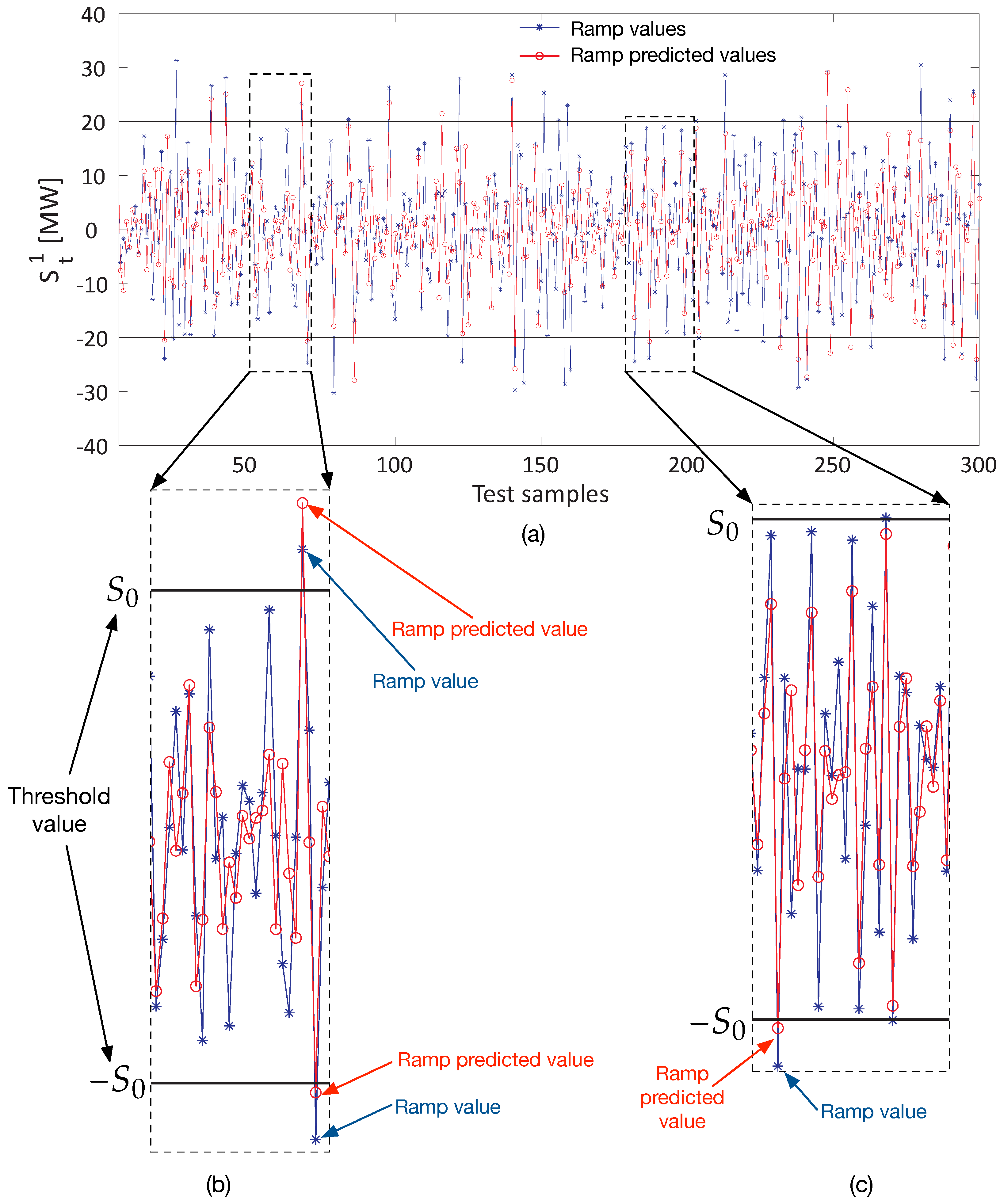
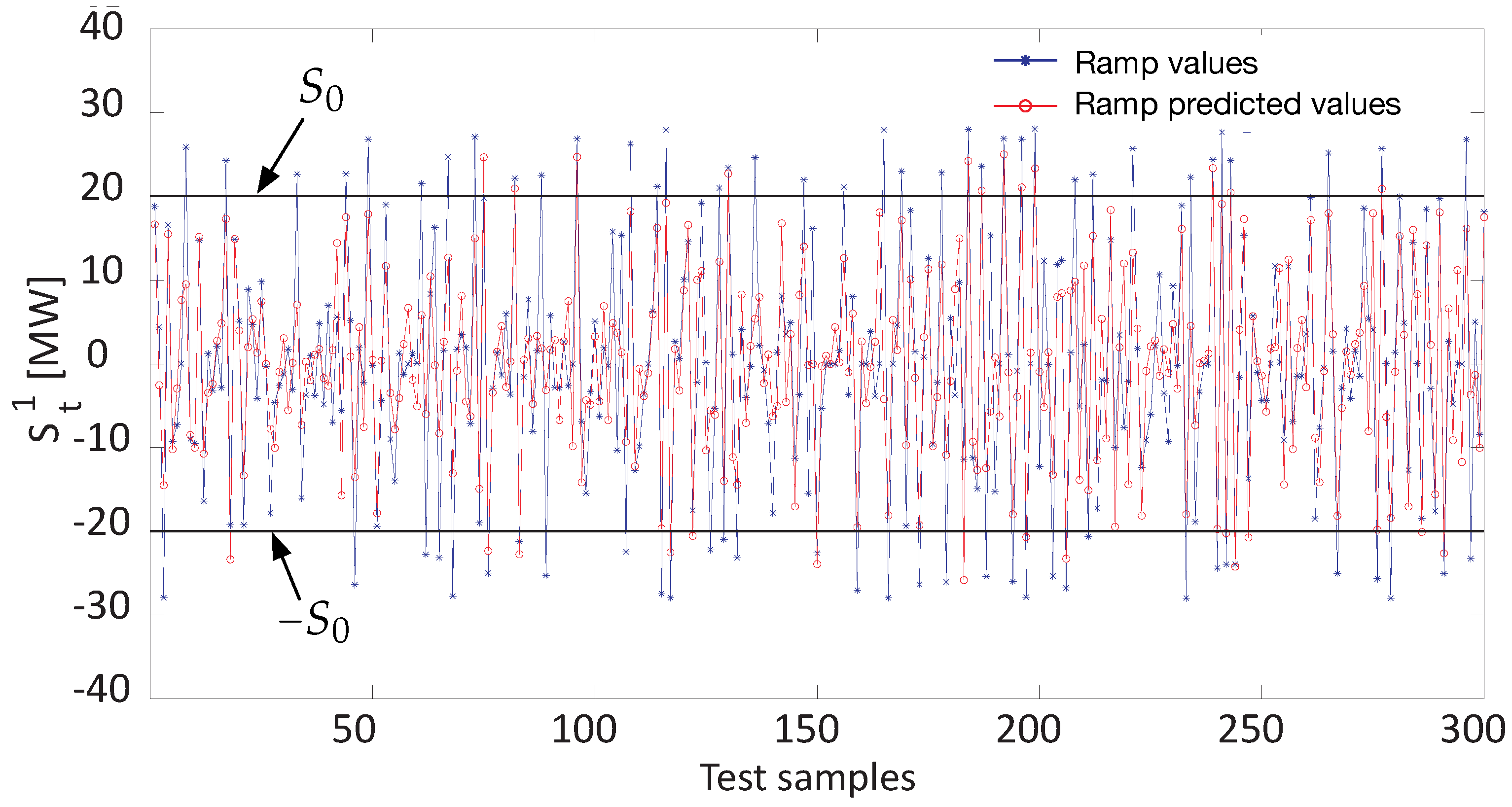
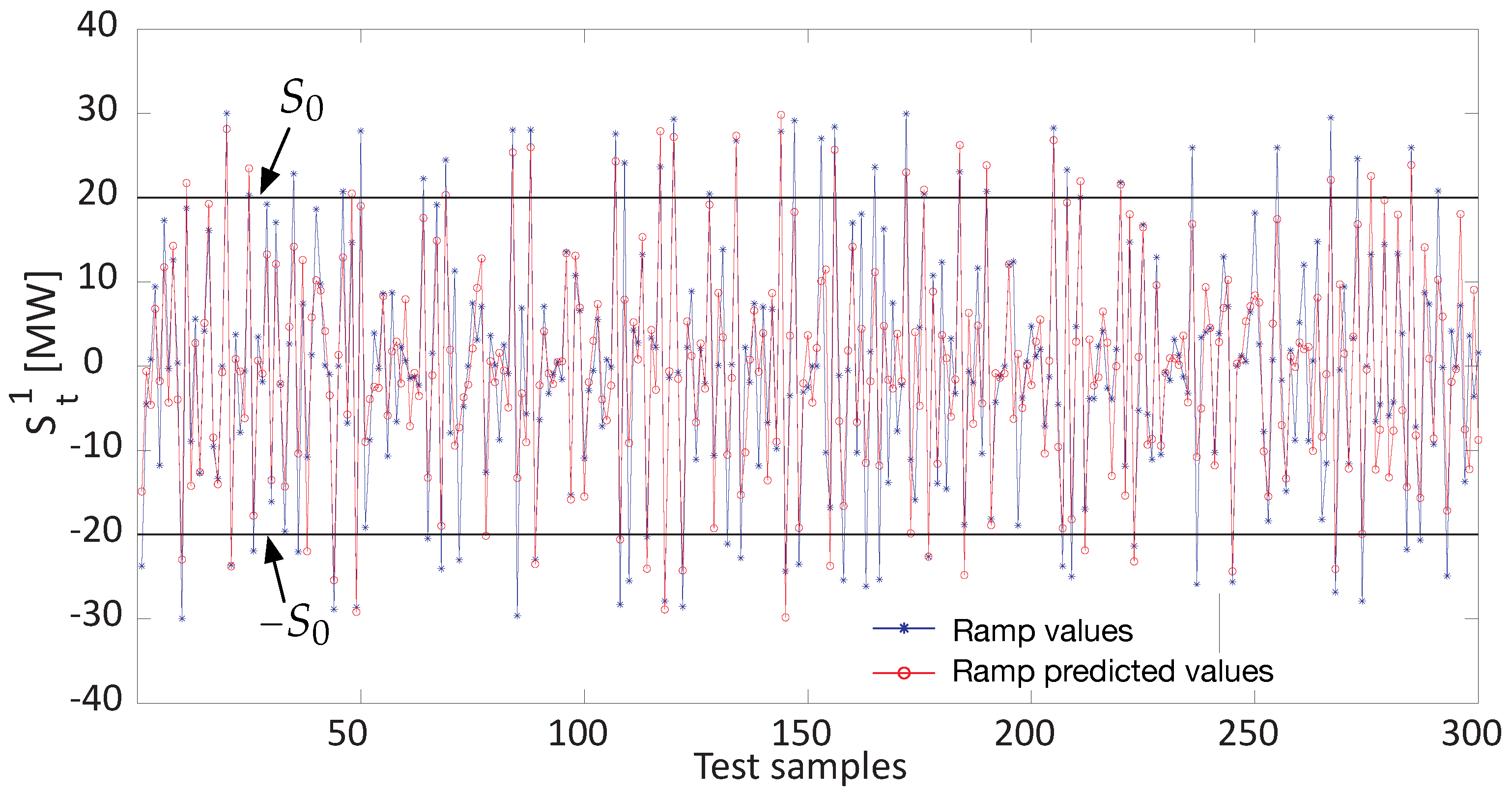
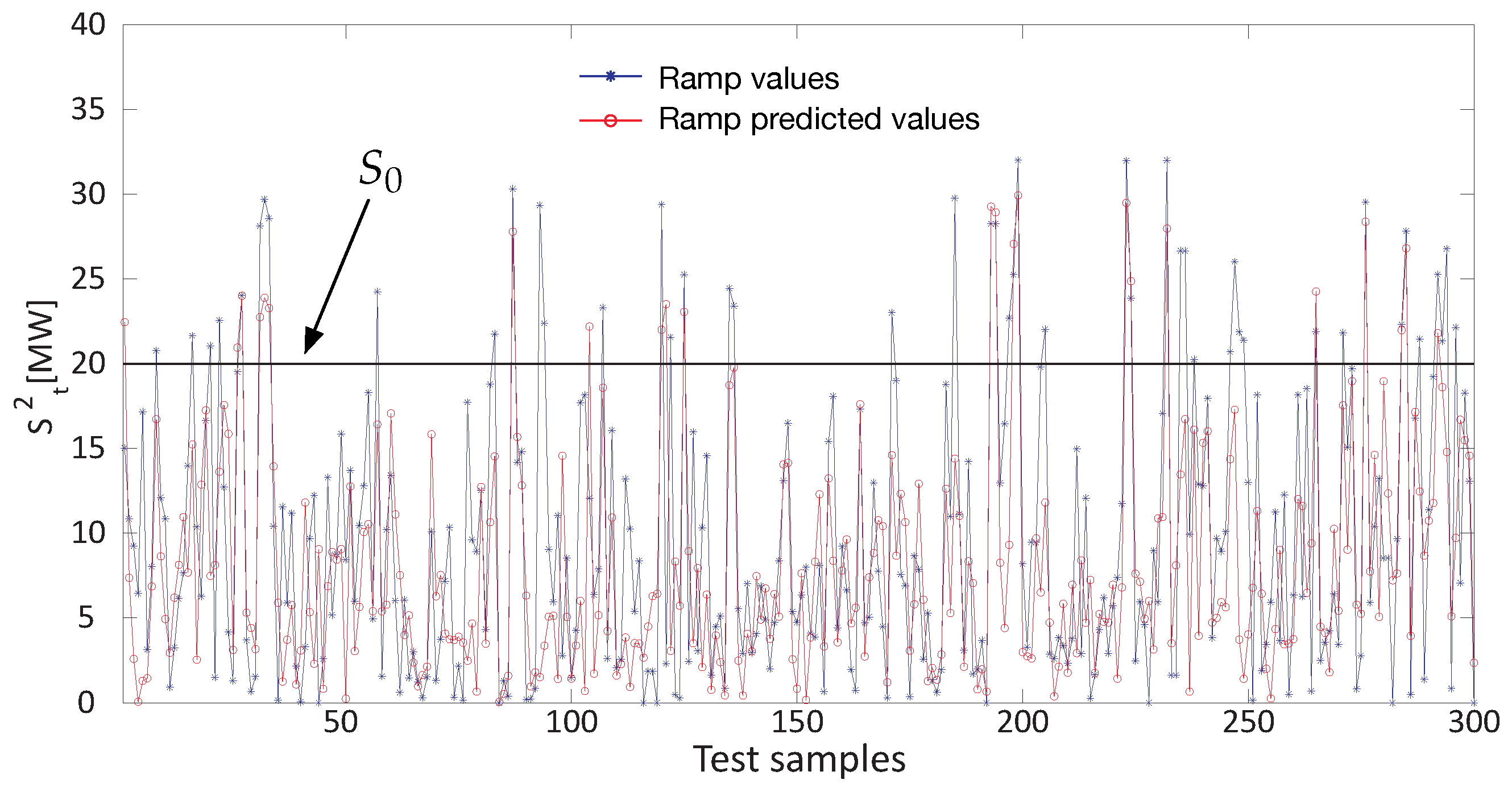
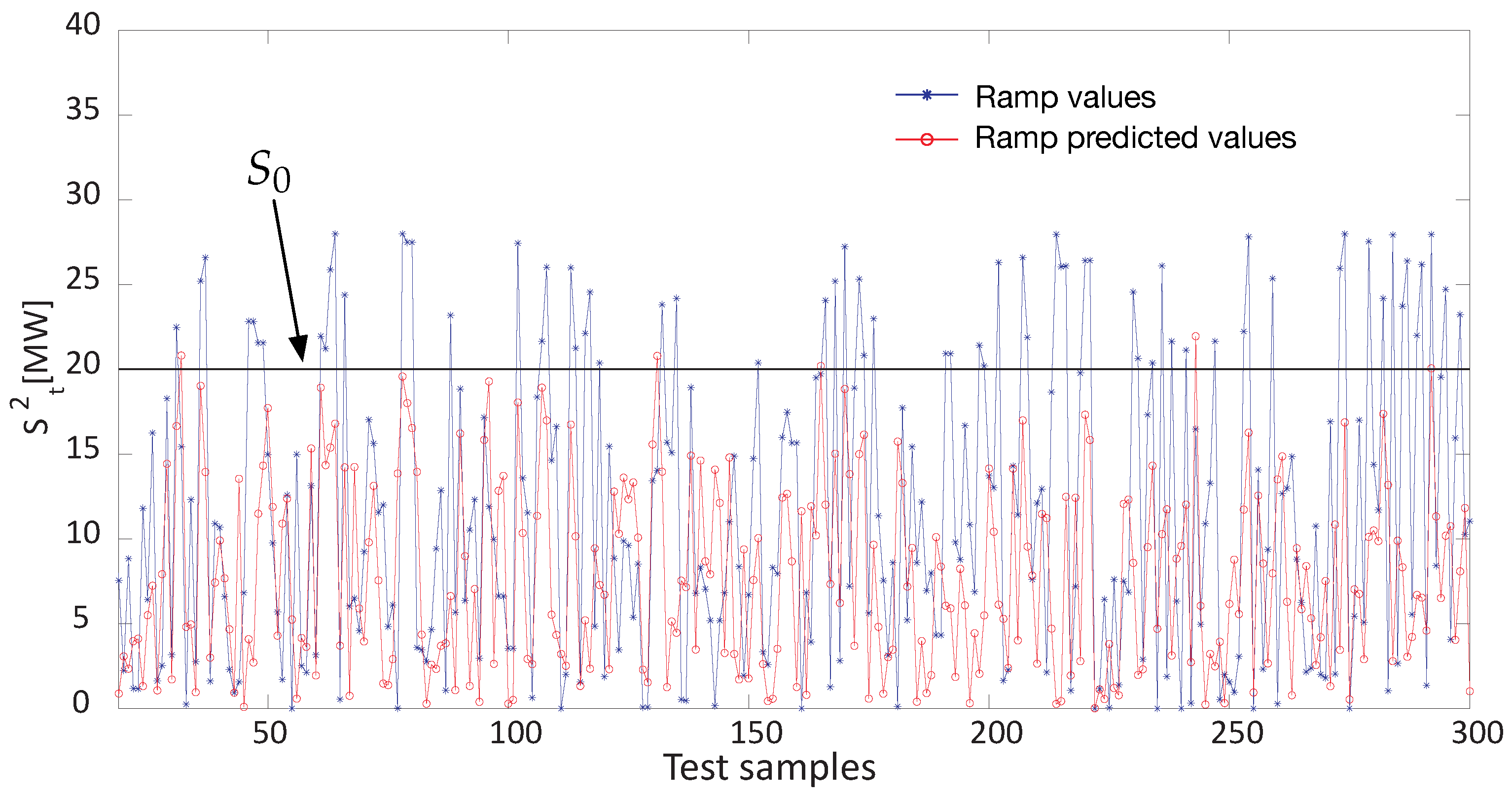
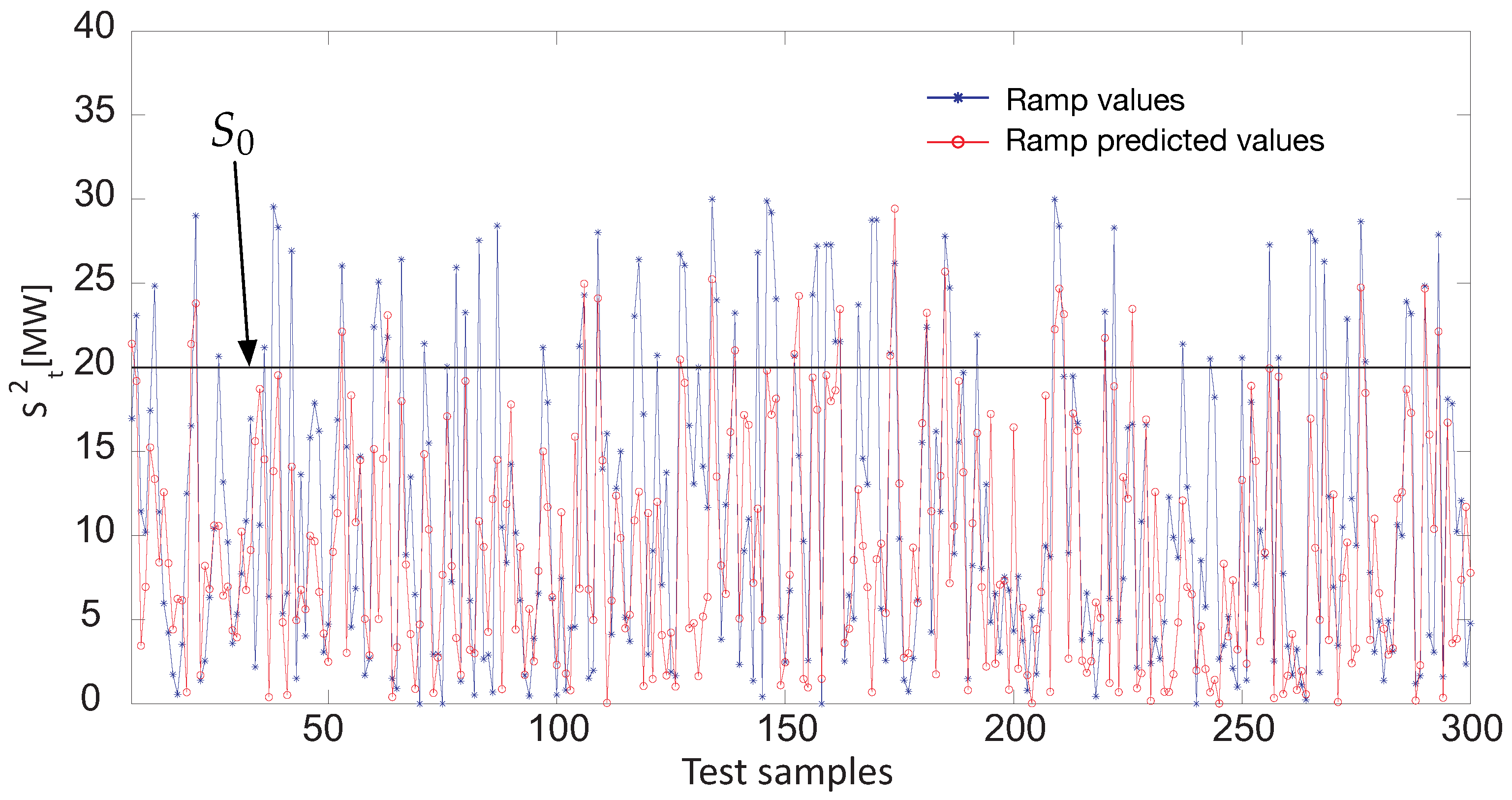
| Acronym | Meaning |
|---|---|
| ANN | Artificial Neural Network |
| ARMA | Autoregressive Moving Average |
| CI | Computational Intelligence |
| CDF | Computational Fluid Dynamics |
| EA | Evolutionary Algorithm |
| EC | Evolutionary Computation |
| ECMWF | European Centre for Medium-Range Weather Forecasts |
| ELM | Extreme Learning Machine |
| FC | Fuzzy Computation |
| GCM | Global Circulation Model |
| GP | Gaussian Process |
| GPR | Gaussian Processes for Regression |
| L1-SVR | L1 Support Vector Regression |
| MAE | Mean Absolute Error |
| ML | Machine Learning |
| MLP | Multi-Layer Perceptrons |
| NC | Neural Computation |
| NN | Neural Network |
| NWM | Numerical Weather Model |
| NWP | Numerical Weather Prediction |
| PCA | Principal Component Analysis |
| RBF | Radial-Basis Function |
| RC | Reservoir Computing |
| RMSE | Root Mean Square Error |
| SAF | Sigmoid Activation Function |
| SDA | Swinging Door Algorithm |
| SVM | Support Vector Machine |
| SVR | Support Vector (machine for) Regression |
| V2G | Vehicle-to-Grid |
| WEST | Wind Energy Study of Territory |
| WPF | Wind Power Forecasting |
| WPREs | Wind Power Ramp Events |
| WRF | Weather Research and Forecasting |
| Variable Name | ERA-Interim Variable |
|---|---|
| skt | surface temperature |
| sp | surface pression |
| zonal wind component (u) at 10 m | |
| meridional wind component (v) at 10 m | |
| temp1 | temperature at 500 hPa |
| up1 | zonal wind component (u) at 500 hPa |
| vp1 | meridional wind component (v) 500 hPa |
| wp1 | vertical wind component () at 500 hPa |
| temp2 | temperature at 850 hPa |
| up2 | zonal wind component (u) at 850 hPa |
| vp2 | meridional wind component (v) at 850 hPa |
| wp2 | vertical wind component () at 850 hPa |
| Model | Model Configuration | Values Used in the Design Parameters for Each Model |
|---|---|---|
| SVR | SVR with Gaussian kernel | , ; , ; , |
| ELM | 3-layer NN with sigmoid activation function | Number of neurons in each of the three layers (input-hidden-output): 48-150-1 |
| GPR | RBF kernel | ; variance(); /4 |
| MLP | Levenberg–Marquardt training | epoch ; gradient ; ; validation-checks |
| Wind Farm A | |||||
| ML Regressor | RMSE (MW) | MAE (MW) | (+ramp) (%) | (−ramp) (%) | (no ramp) (%) |
| SVR | 7.0085 | 5.2673 | 26.93 | 24.20 | 96.59 |
| ELM | 5.6779 | 4.2499 | 40.54 | 42.59 | 95.51 |
| GPR | 5.3066 | 3.9519 | 54.93 | 51.95 | 93.96 |
| MLP | 5.4538 | 4.0021 | 12.13 | 5.72 | 99.41 |
| Wind Farm B | |||||
| ML Regressor | RMSE (MW) | MAE (MW) | (+ramp) (%) | (−ramp) (%) | (no ramp) (%) |
| SVR | 8.0025 | 5.9773 | 35.53 | 34.10 | 86.66 |
| ELM | 7.4539 | 5.9768 | 32.93 | 33.14 | 92.13 |
| GPR | 5.9856 | 4.4298 | 52.10 | 58.25 | 91.71 |
| MLP | 5.9009 | 4.3429 | 15.11 | 13.14 | 97.25 |
| Wind Farm C | |||||
| ML Regressor | RMSE (MW) | MAE (MW) | (+ramp) (%) | (−ramp) (%) | (no ramp) (%) |
| SVR | 7.1370 | 5.3406 | 45.38 | 44.20 | 91.33 |
| ELM | 5.8367 | 4.4462 | 50.32 | 47.64 | 94.01 |
| GPR | 4.7515 | 3.4771 | 57.14 | 61.05 | 93.99 |
| MLP | 5.0727 | 3.6827 | 14.21 | 10.26 | 98.52 |
| Wind Farm A | ||||
| ML Regressor | RMSE (MW) | MAE (MW) | (ramp) % | (no ramp) % |
| SVR | 6.8847 | 5.1876 | 31.33 | 96.27 |
| ELM | 5.7037 | 4.2925 | 41.99 | 95.01 |
| GPR | 5.2048 | 3.7897 | 49.66 | 96.36 |
| MLP | 5.4351 | 3.9861 | 8.71 | 99.44 |
| Wind Farm B | ||||
| ML Regressor | RMSE (MW) | MAE (MW) | (ramp) % | (no ramp) % |
| SVR | 7.9439 | 5.8853 | 44.16 | 85.55 |
| ELM | 7.3148 | 5.8675 | 34.67 | 93.23 |
| GPR | 5.9223 | 4.4037 | 65.32 | 84.12 |
| MLP | 5.9051 | 4.3475 | 14.76 | 97.17 |
| Wind Farm C | ||||
| ML Regressor | RMSE (MW) | MAE (MW) | (ramp) % | (no ramp) % |
| SVR | 7.1525 | 5.4677 | 37.88 | 93.83 |
| ELM | 5.8624 | 4.4368 | 58.16 | 92.10 |
| GPR | 5.1030 | 3.6991 | 57.26 | 94.42 |
| MLP | 5.0605 | 3.6670 | 11.22 | 98.56 |
© 2017 by the authors. Licensee MDPI, Basel, Switzerland. This article is an open access article distributed under the terms and conditions of the Creative Commons Attribution (CC BY) license (http://creativecommons.org/licenses/by/4.0/).
Share and Cite
Cornejo-Bueno, L.; Cuadra, L.; Jiménez-Fernández, S.; Acevedo-Rodríguez, J.; Prieto, L.; Salcedo-Sanz, S. Wind Power Ramp Events Prediction with Hybrid Machine Learning Regression Techniques and Reanalysis Data. Energies 2017, 10, 1784. https://doi.org/10.3390/en10111784
Cornejo-Bueno L, Cuadra L, Jiménez-Fernández S, Acevedo-Rodríguez J, Prieto L, Salcedo-Sanz S. Wind Power Ramp Events Prediction with Hybrid Machine Learning Regression Techniques and Reanalysis Data. Energies. 2017; 10(11):1784. https://doi.org/10.3390/en10111784
Chicago/Turabian StyleCornejo-Bueno, Laura, Lucas Cuadra, Silvia Jiménez-Fernández, Javier Acevedo-Rodríguez, Luis Prieto, and Sancho Salcedo-Sanz. 2017. "Wind Power Ramp Events Prediction with Hybrid Machine Learning Regression Techniques and Reanalysis Data" Energies 10, no. 11: 1784. https://doi.org/10.3390/en10111784
APA StyleCornejo-Bueno, L., Cuadra, L., Jiménez-Fernández, S., Acevedo-Rodríguez, J., Prieto, L., & Salcedo-Sanz, S. (2017). Wind Power Ramp Events Prediction with Hybrid Machine Learning Regression Techniques and Reanalysis Data. Energies, 10(11), 1784. https://doi.org/10.3390/en10111784







